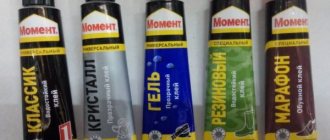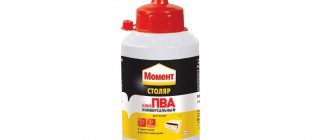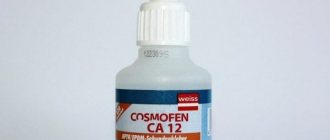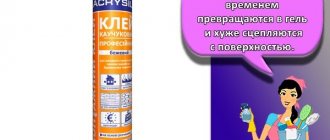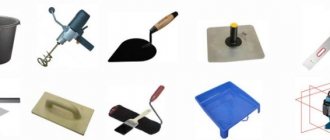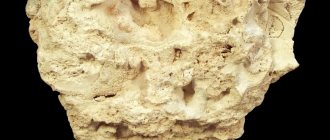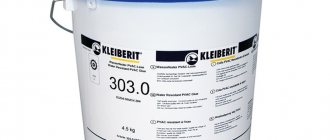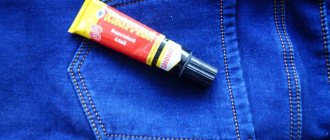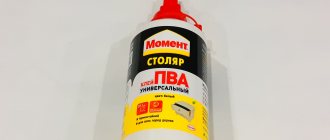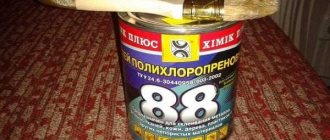Application of Moment glue
Moment glue is produced in accordance with GOST and is recognized as the best product among similar products. This product is one of the most reliable and high-quality adhesives. It is durable, waterproof and strong, sets instantly and comes in a wide range of varieties.
However, there are also disadvantages. Moment glue is often counterfeited; its composition is replaced with a more toxic one, which brings little benefit and a lot of harm. The product also has a sharp, unpleasant odor, although, on the other hand, it is difficult to find glue with a pleasant aroma.
What is superglue
Glue Moment second component necessarily includes cyanoacrylate, its share is 97-99%. This element ensures the rate of hardening of the layer and its strength. May also include plasticizing, stabilizing substances, activators and retarders.
To create Momenta super glue gel, ultrafine silicon oxide is used, which is necessary to obtain a thick structure. No thinners are added to the composition.
The composition sticks together according to the following principle: to begin the polymerization process, moisture is needed, which will be sufficient in the air. As a result, in seconds the glue hardens and turns into a solid state, differing in its strength properties.
Standard types of such adhesives can withstand loads of up to 150 kg/cm2; there are reinforced types that can handle loads of up to 250 kg/cm2. In terms of resistance to high temperatures, the indicator of conventional glue is 70-80 degrees, reinforced 125 degrees.
In seconds, the glue hardens and turns into a solid state, distinguished by its strength properties.
History of the invention of glue
Creating an adhesive that would harden quickly and firmly connect parts was not originally planned by its inventor. The properties of cyanoacrylate to adhere to surfaces were discovered by accident by Harry Coover while he was developing an optical material for sights in 1942.
At that time, the scientist was not interested in such a characteristic of the substance, and he forgot about it. The chemist returned to his observations only nine years later, when he was working on acrylic polymers for aircraft. It was then that he came up with the idea of using the tenacity of cyanoacrylates to produce an adhesive solution.
Inventing a composition that would be perfect took another seven years. And when the product became in demand, the scientist received an award for its creation.
The properties of cyanoacrylate to adhere to surfaces were discovered by Harry Coover.
Peculiarities
The components of the adhesive solution are often changed in order to obtain more interesting options in terms of characteristics. Nowadays, there are many different types of adhesives on sale for different substrates and operating conditions. Only the recipe of the Henkel brand product does not change. But there are still common characteristics for all types:
- Quick initial setting of the layer, complete drying lasts 12-24 hours;
- The adhesive layer does not crack or burst, despite the duration of operation;
- Waterproof property, can be used on items that will interact with moisture;
- Colorless or matte finish;
- High level of resistance to thinners, oils, gasoline;
- Frost resistance;
- Heat resistance.
There are types that conduct electricity; metal particles are added to them. Opposite types can also be found to create electrical insulation.
The components of the adhesive solution are often changed in order to obtain more interesting options in terms of characteristics.
What temperature can it withstand?
The temperature that the majority of adhesives can withstand varies from -60 to +80 degrees.
If it is necessary to withstand more intense high-temperature exposure, special modified types are purchased, according to the instructions, of which they are resistant to exposure up to +300 degrees, and low temperatures up to -200.
The temperature that the majority of adhesives can withstand varies from -60 to +80 degrees.
Storage conditions
For all types of Moment glue there are general and basic storage rules:
- The storage period should not exceed 2 years.
- Can be stored at temperatures from -20 to +30 degrees.
- The composition is highly flammable, so it is necessary to ensure storage away from open flames and heating devices.
But you should also always pay attention to the packaging and study the detailed storage conditions for a particular variety.
Glue Moment (2 videos)
</<iframe src=»https://www.youtube.com/embed/aqBe0Y_O7Og» width=»560″ height=»315″ frameborder=»0″ allowfullscreen=»allowfullscreen»>
Glue Moment (16 photos)
Poisonous properties of cyanoacrylates
Super Moment universal second glue has the property of becoming safe after curing. But at the same time, under the influence of hot liquid, it may begin to turn into a liquid state, for this reason you should not use it to repair dishes used for storing food.
When the glue has not yet hardened, the presence of cyanoacrylate indicates the release of toxic substances; if the concentration is increased, health problems may arise. For safety reasons, it is necessary to use glue in a room where there is a good level of ventilation.
But there are types of cyanoacrylate that are less dangerous and are used in medical adhesives. So there are medical plasters that can be used by surgeons to stop bleeding.
Do not use it to repair dishes used for storing food.
Compound
In this regard, universal glue “Moment” performs better than all other analogues. It is very easy to work with, but most importantly, it dries quickly, so the parts being processed can be used within a day after joining.
This speed is unique and is achieved through the use of special components with good properties. The composition was developed based on numerous tests and finally included:
- — rubber resins based on chloroprene;
- — polyhydric resins of phenol-formaldehyde origin;
- - rosin and its ether compounds;
- — anti-solvent substances that protect the glue from aggressive environments;
- - ethyl acetate;
- - acetone;
- — hydrocarbons of aliphatic and naphthenic structure.
As can be seen from the above list, the composition of the universal glue “Moment 1” is very complex, so it is impossible to prepare it at home. But there will be no problems buying it in the store. The substance can be freely purchased even in a regular grocery supermarket, albeit in a single dosage. If a large volume of construction work is being carried out and a lot of glue is needed, then it will be much more economical to purchase packages with maximum capacity.
They will last longer, and the glue inside will not dry out, since the jars are specially designed for long-term storage. In construction, “Moment” universal adhesive 750 ml is most often used, since this is the largest package available today.
Advantages
The demand for adhesives called Moment is due to the variety of compositions that are intended for various substrates. The funds are available, it is not difficult to find them on sale, and the cost is reasonable.
Containers of different types and volumes are produced. The following advantages of the compositions can also be highlighted:
- They do not shrink, the layer will not change shape over time;
- Withstand aggressive influences;
- Create long-lasting results;
- Ease of use;
- A number of good properties;
- Applicable as sealing agents.
The demand for adhesives called Moment is due to the variety of compositions that are intended for various substrates.
Varieties
Manufacturers produce a huge number of varieties of Moment series adhesives. You can really find an option for any task. So the funds are divided into the following categories:
- Contact;
- For wooden surfaces;
- Polyurethane foams;
- For wallpapering;
- Tapes for sealing work;
- Stationery;
- Seconds;
- Tiled;
- Epoxy;
- Shoe;
- Liquid Nails.
This is the main list, but there are other types. This is how the Moment “Pro”, “Rubber”, “Crystal”, etc. are distinguished.
Manufacturers produce a huge number of varieties of Moment series adhesives.
Negative sides
Moment rubber adhesive, classic, universal or any other, has not only a lot of advantages and positive qualities, but also several disadvantages:
- There are quite a lot of fakes that contain harmful and toxic components.
- The presence of a specific odor.
- The difficulty of cleaning the skin from glue that has accidentally fallen on its surface and has had time to dry.
It is important to know! Any type of Moment glue is not capable of connecting polypropylene and polyethylene to each other due to the peculiarities of the chemical composition.
Instructions for proper handling of the material
The products in this series can glue a variety of materials: metal, wood, plastic, paper, leather and more. But when working with shoes, take into account that glue is not suitable for soft types of leather materials. To get a durable and reliable result, you need to do the work correctly. The gluing steps include the following:
- The adhesive layer must be applied to a cleaned and dried surface;
- In order for the level of adhesion to be higher, it is necessary to degrease the base;
- When the glue is spread on the surface, both parts are immediately fastened together;
- The drying time depends on the humidity level in the room; the higher it is, the faster the pace will be;
- Make sure that air does not accumulate; its presence can lead to a decrease in the strength characteristics of the layer.
To get a durable and reliable result, you need to do the work correctly.
Tips for use
There are several useful tips that you should familiarize yourself with before using the adhesive liquid:
- Before carrying out work, you need to figure out what temperature the glue can withstand. The operating temperature should be in the range of 5-25 degrees Celsius. At temperatures below zero, using “Moment” is not recommended.
- To ensure better gluing, all surfaces to be treated are first cleaned of dust and other contaminants.
- When applying superglue, you must use a brush, which will help distribute the mixture evenly over the entire surface.
How to work correctly with cyanoacrylate superglue - procedure
Gluing objects with quick-drying compounds is not difficult; you just need to be quick and precise to connect the elements together correctly. Due to the speed of drying, correction of the joint is almost impossible; there is time for this only when working with soft bases, then hardening takes a little slower.
Also, do not forget to be careful so as not to drip the product onto an unnecessary area; it will be difficult to wash the layer.
If you are going to correct large defects, then you should fill the recesses with a plaster mixture, soda, and then apply glue, then the recess will be filled. The base is cleaned, all types of contaminants are removed, and greasy stains are removed with a suitable thinner. Then follow the steps below:
- The cap is used to pierce the tube protection;
- The glue must be applied to a dry surface; another part is immediately glued onto the layer;
- You should start gluing from the central part to the edge to prevent the formation of air;
- The elements are squeezed together for half a minute;
- Wait for the layer to dry.
After work, the remaining glue is removed from the tip of the container so that it can be tightly closed and opening will not be difficult.
Do not forget to be careful so as not to drip the product onto an unnecessary area; it will be difficult to wash the layer.
Types of PVA glue
Today there is more than one composition of PVA glue. Varieties are classified depending on technical characteristics, industry of application and other factors.
The following types of PVA are found on store shelves:
- Super (PVA-M). It contains additional components, due to which, after the glue dries, the strength significantly increases. It is recommended to use for household needs, gluing any wallpaper, installing tiles. It is packaged in small tubes with a spout and a lid, so that if desired, you can use it to make a thin seam to glue lagging elements or restore small damaged areas.
- Stationery (PVA-K). It is actively used in everyday life, usually for children's crafts. The product is available in liquid or dry form. In the first case, it is poured into small bottles, in the second, it is formed into solid PVA pencil glue.
- Universal (PVA-MB). The composition is always ready for joining cardboard, leather, wood and glass products. Ideal for processing carpet, linoleum, serpyanka, etc. The mixture is often sold in buckets.
- Construction (waterproof PVA emulsion) with polymerizing particles is intended more for compacting building mixtures, but can also be used as an independent tool for working with durable and heavy materials. In stores, this glue is found both in small tubes and in jars or buckets.
- Household (wallpaper). This variety provides good adhesion to concrete, brick, plasterboard and plaster. Also suitable for gluing heavy canvases and working with paper, foam rubber, and textiles. The product is usually sold in large buckets or jars.
We recommend: Pufas universal kleber construction adhesive (10 kg)
Tips and tricks
Due to the toxicity of the composition in the liquid state, it is necessary to remember to follow safety precautions. High-quality ventilation is created in the room, or you can wear a respirator. If signs of illness appear from prolonged inhalation of toxic substances, immediately seek medical help.
You cannot work near open sources of fire; many compounds are classified as highly flammable.
High-quality ventilation is created in the room, or you can wear a respirator.
Precise dosing and application
To apply the exact amount of glue, first squeeze out a little onto the base and immediately spread it over the area using paper or a match; if necessary, squeeze out a drop of glue again and fill the remaining area. Afterwards, the elements that need to be glued are pressed and held in this position for about half a minute.
The elements that need to be glued are pressed and held in this position for about half a minute.
Peel and unstick
Often the fingers get stuck together when working. You can wash off the glue by immersing your hands in warm water to soften the bond. You can soak the skin with vegetable oil. Separate your fingers from each other slowly, without sudden movements, so as not to cause a wound; gradually the layer will lose its strength, and the glue can be completely cleaned.
You can wash off the glue by immersing your hands in warm water to soften the bond.
Moment series glue gives high-quality results, but repairs will require a little time. Its use is simple, and you can find a suitable option for any type of base. The variety of compositions and reasonable cost have made the glue in demand. If you are careful, you can glue two parts together for a long time and unnoticeably.
Bonding technology
There are quite often situations in life when it is necessary to repair a broken or broken item. Therefore, universal transparent glue “Moment” should be in every home. No special skills are required to work with it. You just need to first clean both surfaces of debris, burrs and shavings to ensure maximum tight contact.
Then they are degreased with any liquid suitable for this operation and allowed to dry. The glue must be applied to both surfaces and allowed to sit a little for 5-10 minutes. After this, you need to press the products against each other as hard as possible, but at the same time taking into account their fragility, so as not to accidentally break them even more.
A shutter speed of 3-5 seconds is enough, after which you can put the part in any convenient place where it will not disturb anyone. You can start using it just one day after the operation.
